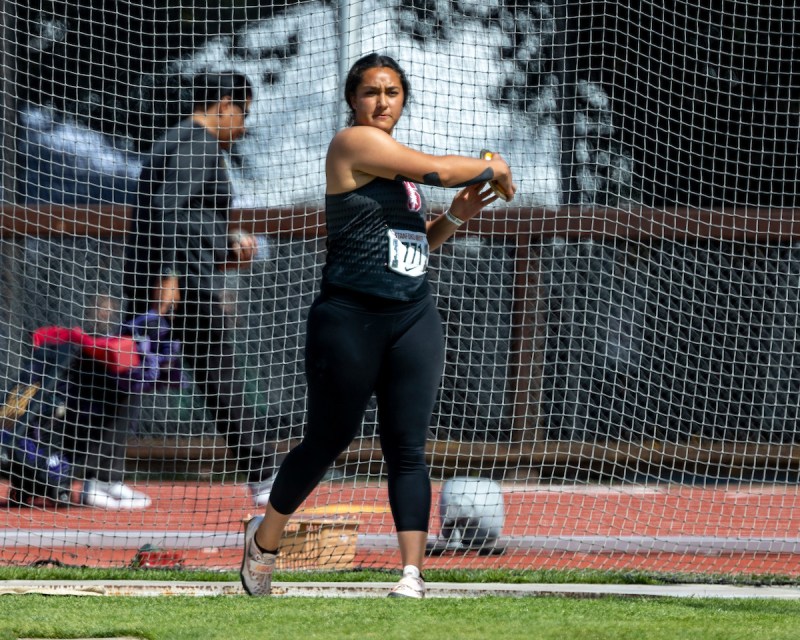The laws of Olympia were written on a discus in the Hera Temple. At the ancient games, the original Olympics which long preceded the televised rituals of a new world, discus shined. Homer wrote of its might, with godlike heroes such as Odysseus and Achilles solidifying their legacies by unleashing their discs into the air and surpassing the marks of their opponents.
Today, people file into stadiums, excited to watch the sprinters fly across the track, high-jumpers spring and arch unto the mats, bar unscathed and in place. But behind the seated rows, far past the chatter and booming voices of announcers overhead, lie the throwing pits with dust rising over the white lines on the field.
For Stanford’s women throwers, sophomores Brandy Atuatasi and Kaiah Fisher, discus is more than antiquity. It runs in their blood, a craft passed down by their families, sustained between generations. Their sport means more to them than to the spectators that gather to witness it.
Both athletes were introduced to throws by their parents. Atuatasi, hailing from San Diego, Calif., picked up throwing from her older sister, who picked it up from their father. Fisher’s parents met in college while competing in throws, and together they passed it down.
Atuatasi still remembers telling her father that she was being recruited by Stanford and witnessing him and her mother cry at the news. “It’s just that for my parents, growing up, there weren’t many opportunities for women and girls in sports during their time,” she said.
In the Atuatasi family, sports might as well have been coded into their genes – growing up, Brandy played 10 of them. For her, discus ended up being the perfect fit. It was an outlet, a space where she could hone her strength and self-discipline.
Fisher steps into the ring at Cobb Track and Angell Field. It looks just as she envisioned it in bed last night. Many athletes have pre-match rituals, ways to prepare themselves for the mental aspect of competition. For some, it’s overthinking; for others, thinking nothing at all. For Fisher, she walks herself through the entire competition a whole day in advance. She visualizes the ring, the background of the pits, her name being called before her throw.
“When it comes to competition time, and my name gets called, I walk in the ring and think, ‘I’ve been here. I know what to do. I’m here right now and I can be present,’” Fisher said.
She holds a 2.2-pound disc in her hand, slightly lighter than those launched in Ancient Greece. But it weighs the same as the discs she would let rip from her ranch in a little town called Applegate, Ore., population 6,916, where everybody knows everybody else and the town boasts a café, a library and a church. The tranquility there is not too different from the quiet of the throwing pits. Fisher, as many others do, has big dreams. She hopes to bring joy and pride back to her small town, to her parents who inspired her to embark on this journey that would begin at her ranch and end at the ring.
She has three chances, three throws, to do just that.
Throwing is just as mental a sport as it is physical. The body, through memory-building and calculated movement, must achieve two core elements: repeatability and predictability. It must obey the laws of physics, momentum and torque, at nearly perfect accuracy to deliver a good throw. Atuatasi and Fisher get about 50 throws in at each practice, in hopes of excelling in one of the three allotted to them during competition.
“All of your work that you’ve ever put in, it’s only expressed through a single set of numbers. Sometimes it can feel like you’re just that – a number,” Fisher said.
It doesn’t help that despite all of their hard work, throwers are covered the least out of any event in Track and Field. Fisher recalls watching replays of filmed content from their meets, noting that the cameras stayed on the sprinters and long-distance runners — even during their warm-ups — while the throwers were competing.
“I just think if more people knew about throws in general, more people would go out and do it,” Fisher said.
Although times have changed, representation of women’s throwing has only improved slightly. In its nature, throwing requires incredible strength and muscle.
“Women in throws, we love lifting, we love getting dirty, we’re out there working hard and getting super strong,” Fisher said. “I wish more people understood that not everything you are is how you look. More so, what you can do, how you think, how you feel, how you interact with others.”
For most women in throwing, the Olympics may seem like more of a pipe dream than a goal. From the rigorous maintenance required to keep the body and technique in tune, to the aging process that can alter one’s entire form in just a year, the challenges pile up and seem to obscure any visibility of that dream.
Atuatasi’s personal best clocks in at 162.3 feet, Fisher’s at 166.10 feet. The qualifying round for the Olympics requires a baseline of 192 feet. What may seem like a small difference between their PRs and the Olympics actually entails years of work and technique refinement.
But so what if the Olympics aren’t in the cards for these throwers? Does that mean their countless hours of training, throwing and lifting were for nothing?
“It has played a big part in developing who I am: my discipline, my time management, how I respond to conflict,” Fisher explained. “Even if I don’t continue to throw, I will always be a strong woman who is confident and knows she can accomplish something.”
